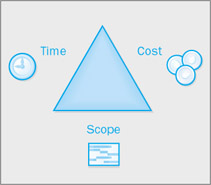The Project Triangle: Seeing Projects in Terms of Time, Cost, and Scope
You can visualize project work in many ways, but our favorite is what’s sometimes called the project triangle:

This theme has many variations, but the basic idea is that every project has some element of a time constraint, has some type of budget, and requires some amount of work to complete. (In other words, it has a defined scope.) The term constraint has a specific meaning in Project, but here we’re using the more general meaning of a limiting factor. Let’s consider these constraints one at a time.
Time
Have you ever worked on a project that had a deadline? (Maybe we should ask whether you’ve ever worked on a project that did not have a deadline.) Limited time is the one constraint of any project with which we are all probably most familiar. If you’re working on a project right now, ask your team members what the project deadline is. They might not know the project budget or the scope of work in great detail, but chances are they all know the project deadline.
Here are some examples of time constraints:
-
You’re building a house and you must finish the roof before the rainy season arrives.
-
You are assembling a large display booth for a trade show that starts in two months.
-
You are developing a new inventory tracking system that must be tested and running by the start of the next fiscal year.
Most of us have been trained to understand time since we were children, and we carry wristwatches, paper and electronic organizers, and other tools to help us manage time. For many projects that create a product or result in an event, time is the most important constraint to manage.
Cost
You might think of cost simply as dollars, but project cost has a broader meaning: costs include all the resources required to carry out the project. Costs include the people and equipment who do the work, the materials they use, and all the other events and issues that require money or someone’s attention in a project.
Here are some examples of cost constraints:
-
You have signed a fixed-price contract to deliver an inventory-tracking software system to a client. If your costs exceed the agreed-upon price, your customer might be sympathetic but probably won’t be willing to renegotiate the contract.
-
The president of your organization has directed you to carry out a customer-research project using only the staff and equipment in your department.
-
You have received a $5,000 grant to create a public art installation. You have no other funds.
For virtually all projects, cost is ultimately a limiting constraint; few projects could go over budget without eventually requiring corrective action.
Scope
You should consider two aspects of scope: product scope and project scope. Every successful project produces a unique product: a tangible item or a service. You might develop some products for one customer you know by name. You might develop other products for millions of potential customers waiting to buy them (you hope). Customers usually have some expectations about the features and functions of products they consider purchasing. Product scope describes the intended quality, features, and functions of the product—often in minute detail. Documents that outline this information are sometimes called product specifications. A service or an event usually has some expected features as well. We all have expectations about what we’ll do or see at a party, a concert, or a sporting event.
Project scope, on the other hand, describes the work required to deliver a product or a service with the intended product scope. Whereas product scope focuses on the customer or the user of the product, project scope is mainly the concern of the people who will carry out the project. Project scope is usually measured in tasks and phases.
Here are some examples of scope constraints:
-
Your organization won a contract to develop an automotive product that has exact requirements—for example, physical dimensions measured to 0.01 mm. This is a product scope constraint that will influence project scope plans.
-
You are constructing a building on a lot that has a height restriction of 50 feet.
-
You can use only internal services to develop part of your product, and those services fol low a product development methodology that is different from what you had planned.
Product scope and project scope are closely related. The project manager who manages project scope well must also understand product scope or must know how to communicate with those who do.
EAN: 2147483647
Pages: 199